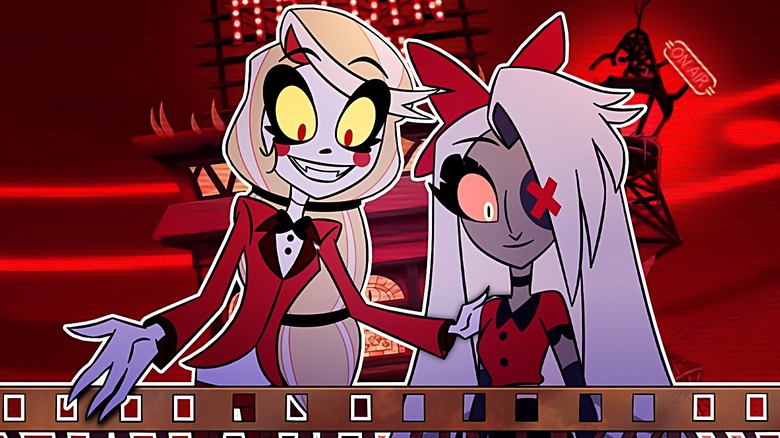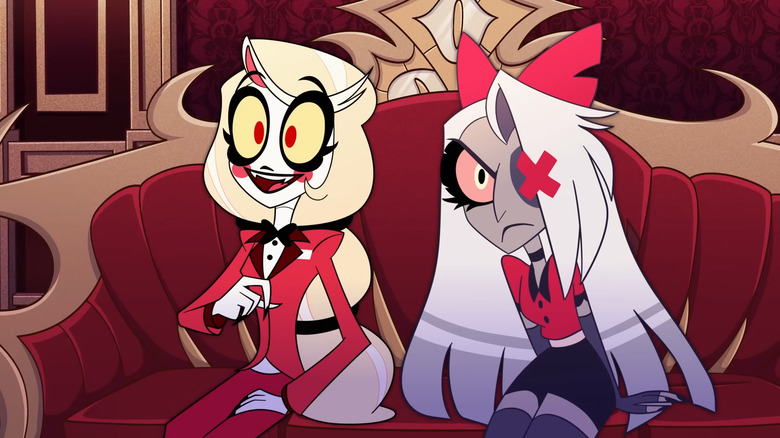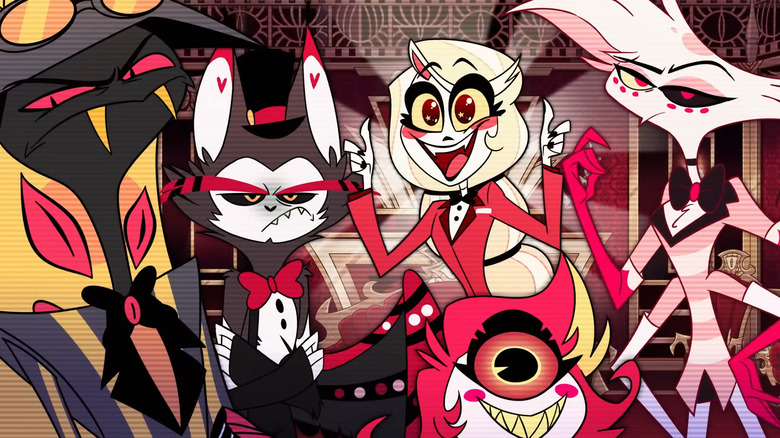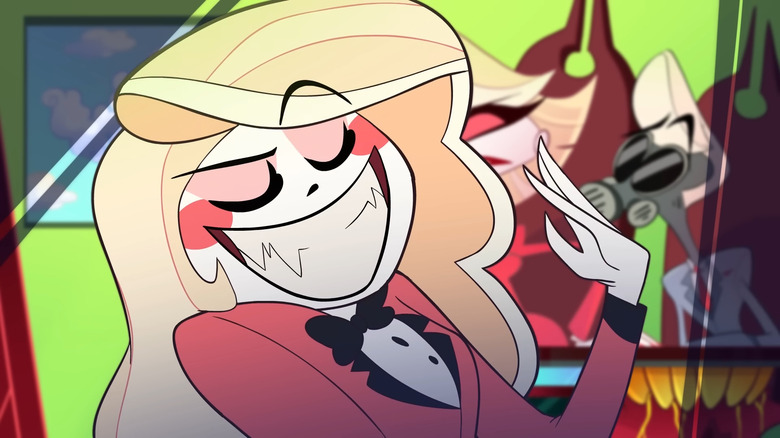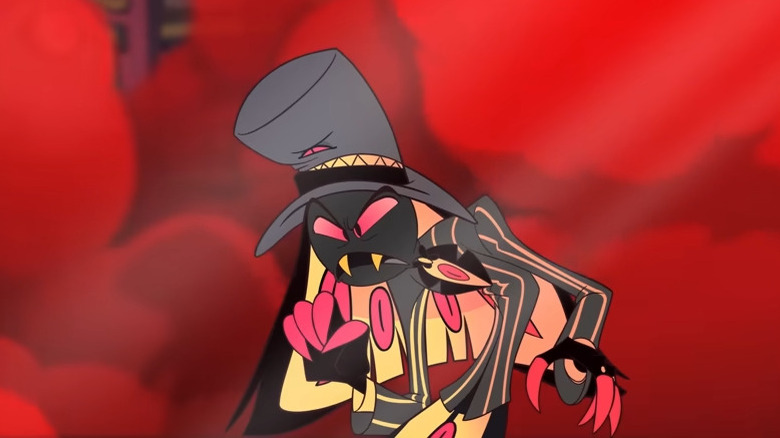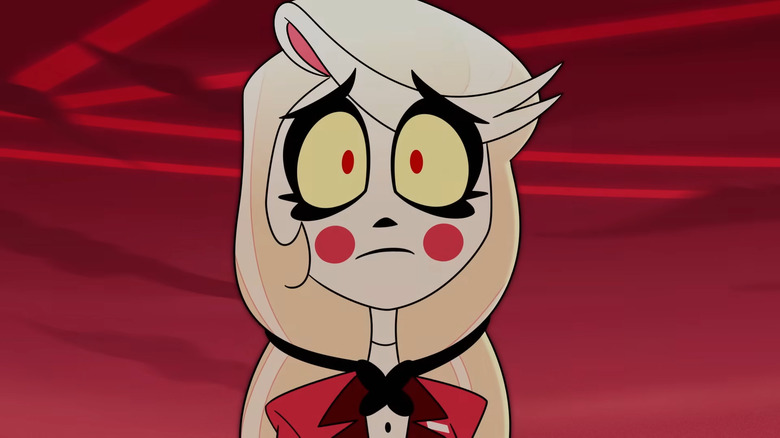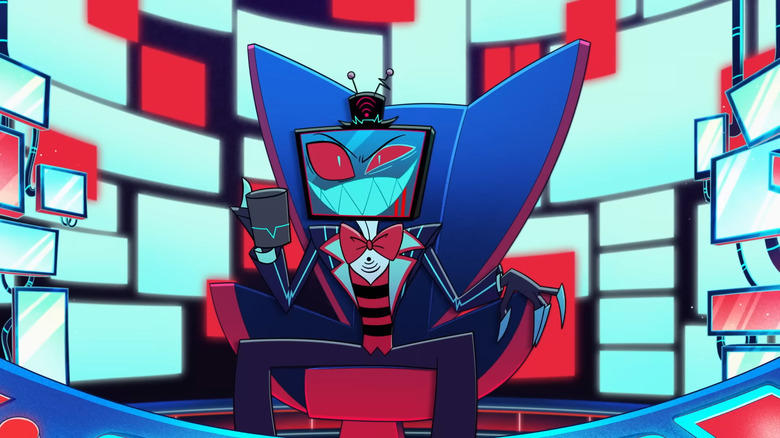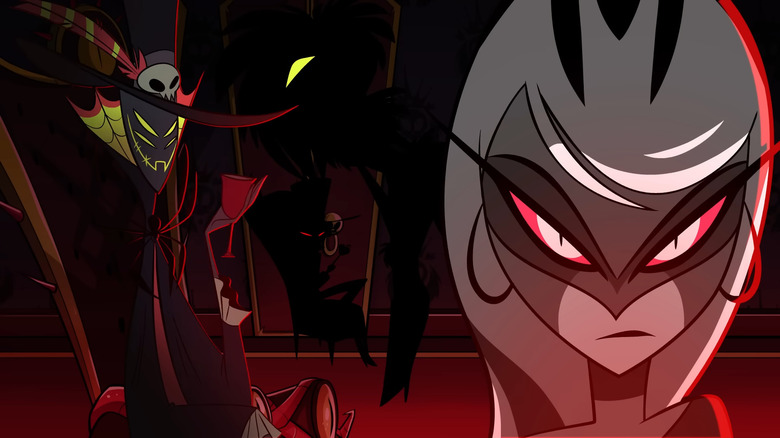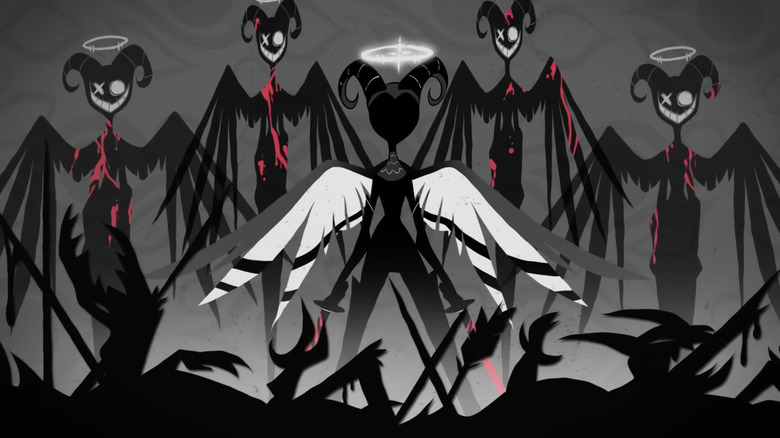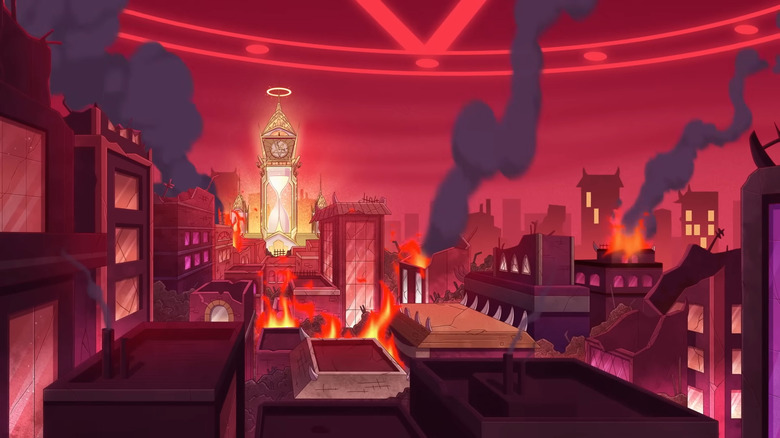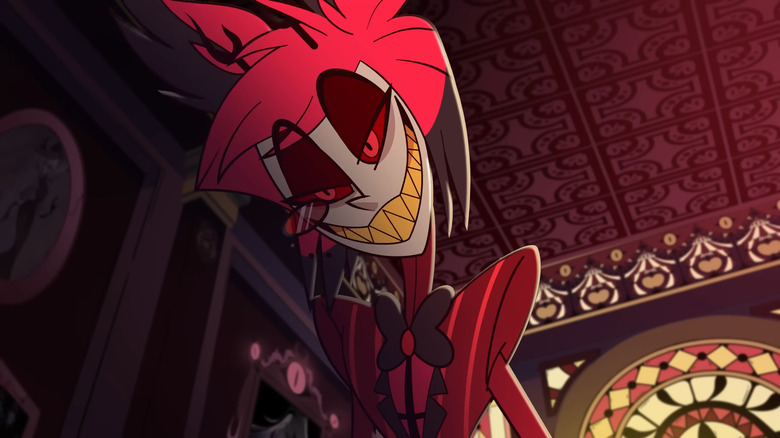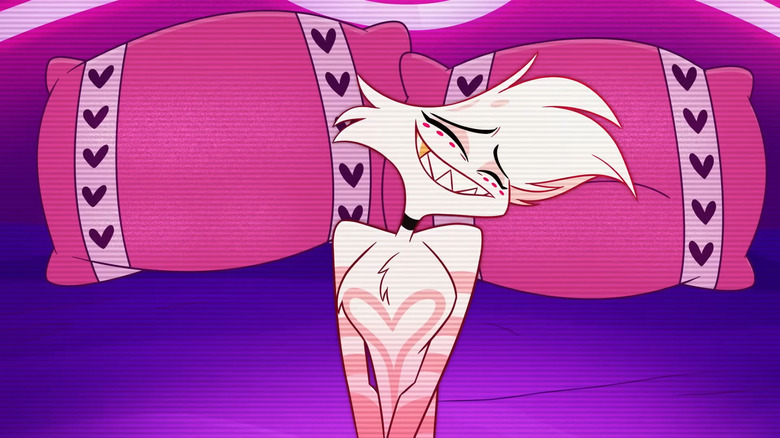The Biggest Differences So Far Between Hazbin Hotel's Pilot And The Official Show
There are two kinds of people in this world: those who've never heard of "Hazbin Hotel," and those who've been waiting the last four years for the series to finally arrive. A gorgeously grotesque animated mishmash of genres and styles, the show began its life back in the fall of 2019 when creator Vivienne Medrano posted a 30-minute pilot episode to her YouTube channel. In the years since, that pilot has accrued over 94 million views, and Medrano inked a deal with A24 to develop it into a complete series. Now, after what probably feels like an eternity to day-one fans, the show has finally arrived on Prime Video, but it's a little different from what we saw in the pilot.
The core story, style, and characters are the same. Charlie Morningstar, princess of Hell and incessant do-gooder, gets fed up with the perpetual cycle of violence in her realm. Every year, angels descend from Heaven and decimate the populace of Hell in what's known as an Extermination, thus preventing the land of sinners from ever gaining enough strength to rise up. Charlie envisions a better method — rehabilitation — and sets up the titular hotel as a place for sinners and demons to stay while working to redeem their souls.
Inevitably, things change when moving from a crowdfunded indie animation project to a full-blown studio-produced series at Amazon. So, let's look through the first few episodes of "Hazbin Hotel" and see what's changed since the pilot dropped in 2019.
The animation style in the full show is different
The first thing fans of the "Hazbin Hotel" pilot will probably notice when watching the Prime Video series is that the animation style is a bit different. Of course, that's to be expected. The pilot was created solely through Vivienne Medrano's own independent studio SpindleHorse Toons, while the Amazon series is a collaboration between SpindleHorse, A24, and Bento Box Entertainment, the latter of which has worked on major shows like "Bob's Burgers" and "The Great North."
If it's been a while since you've seen the pilot, the differences might not be too apparent. The character designs — Medrano's calling card in many ways — are mostly the same and still spectacular. But if you watch the two versions side-by-side, you'll instantly see some differences in style. Medrano's pilot was a more overt homage to older styles, blending gory and depraved subject matter with absurdist animations more akin to old "Looney Tunes" skits. The pilot also pulls heavily from the late 1990s and early 2000s, and "Invader Zim" in particular, which Medrano has cited as one of her biggest animation inspirations. It's a lot of hard edges and Dutch angles, creating a visual vibe that's as claustrophobic as it is colorful.
The Prime Video series is, put simply, a bit less extravagant and extreme in its visuals. That may be due to budget realities of a longer-term project, or the changes in production, or both. In the musical numbers, you can still see the dramatic style shifts and occasional silhouette animation moments that filled the pilot, but they aren't as prevalent elsewhere. The Prime Video series still looks great, though, and it hasn't lost what made the pilot feel unique.
Overall, the characters are more grounded
Just as the animation has become a bit less severe in the transition from pilot to series, so too have the characters evolved into more grounded versions of their original selves. In the pilot, Charlie comes across like the only person in Hell who's operating under normal human emotions. Angel is portrayed as a hyperactive crook who loves violence just as much as he loves drugs and sex; Husk and Niffty only appear briefly, and even Vaggie feels much more aggressive and less balanced in the pilot than she is in the full show.
To be fair, most of these differences can be viewed as instances of character development, rather than actual changes. In the Amazon Prime show, Angel takes a while before he starts to lower his mask and get vulnerable with people. But even at their most ridiculous, the newer versions of the characters feel more grounded and less, well, cartoonish. They all show a wider range of emotions from the start, creating a more accessible ensemble for a full show.
Arguably the biggest character change, though, belongs to Alastor the Radio Demon. He appears at the end of the pilot as a kind of psychotic, eldritch nightmare, hiding his true nature behind a veneer of olde-timey charm. That's still his deal in the full series, but he's notably less terrifying. His vocal filter is toned down, his character design is a bit softer, and he actually seems to believe in Charlie's mission. He makes fun of it constantly, sure, but he's not nearly as malicious as he is in the pilot.
The entire cast is new
In the four years since the "Hazbin Hotel" pilot was released, some fans may have watched it numerous times. Unfortunately, if you've become accustomed to the sounds of the original voice actors, you won't find any of them in the new show. Every main character has been recast, many with big-name actors. For better or worse, that's often the way of things when big studios get involved.
Charlie, who was voiced by Jill Harris in the pilot, is played in the Amazon series by Broadway star Erika Henningsen. Original Vaggie actor Monica Franco has been replaced by "Brooklyn Nine-Nine" star Stephanie Beatriz, Alastor's Edward Bosco was replaced with Amir Talai, and Angel Dust's original voice actor Michael Kovach has been swapped out for Blake Roman. Miffty, Sir Pentious, and Husk have also gotten new voices, with Kimiko Glenn replacing Michelle Marie, Alex Brightman replacing Will Stamper, and voice-acting legend Keith David replacing Mick Lauer.
The new cast is great, and they have a lot of big-deal voice-acting credits between them. Still, it's hard not to miss the original stars of the pilot when watching the first episode of the Prime Video series. Soon, the new actors will become the voices fans hear in their heads when they picture the different characters, but we'll always have the originators to appreciate as well.
The pilot is paced much more frenetically
When you have a full eight-episode season to tell your story, things don't have to be as rushed as they might be in a 30-minute short. That could be the reason why the pacing of Prime Video's "Hazbin Hotel" feels so much more relaxed than the pilot. However, there also seems to be an intentional style change, dropping some of the original's frenetic editing and subbing in a more conventional narrative structure for the first few episodes.
The pilot is disorienting on purpose. Characters slither and jump about in impossible ways, and any cut might be accompanied by a complete shift in color or animation style. In its 30 minutes, the pilot doesn't really give you a second to breathe. Each character introduced is strange and somewhat frightening, and they're shown in a way that's meant to keep you on your toes.
That's simply not the case in the full series. The unique character designs are still present, but they don't move in the bizarre ways that define the pilot. Scenes have a more traditional build, and you get to sit with individual moments for longer, rather than being quickly tossed along to something else. The new approach isn't necessarily better or worse than the original, but it will certainly be more accessible to viewers who aren't as well-versed in experimental animation.
Lilith has been gone for much longer than fans may have thought
In addition to all the stylistic changes, Prime Video's version of "Hazbin Hotel" makes some narrative tweaks to the story laid out in the pilot.
For the most part, the season feels like a natural continuation. When Sir Pentious arrives in Episode 1 to attack the hotel, we're told that it's been a week since his last assault, which occurs at the end of the pilot. Similar details are littered throughout the premiere episodes to let us know where we are in relation to the pilot, such as Alastor taking credit for the Hazbin Hotel's name and the season beginning right after an Extermination. However, there are also some interesting changes.
One detail we get in the full show is that Charlie's mother, Lilith, the first human woman, has been missing for seven years. The pilot features a scene in which Charlie calls her mom and leaves a voicemail, showing that she's "busy" at the moment, but we don't get the sense there that it's been such a long time, or that Charlie doesn't actually know where Lilith is. It's also worth noting that Alastor was also missing for seven years before returning at the start of the show. Could these two characters have been in the same place? Is that why the Radio Demon has actually come back to help Charlie?
The politics of Hell are more civil in the full show
In the "Hazbin Hotel" pilot, the aftermath of the Extermination is depicted as widespread chaos. The news reports turf wars being fought by different overlords of Hell, which are shown as full-on gun battles in the streets. Taking and holding power in Pentagram City seems to be a violent thing, with very little respect or diplomacy shown between the different overlords.
We get a very different picture of Hell politics in the full show, however. In particular, Episode 3, "Scrambled Eggs," features a meeting between the leading overlords of Pentagram City, including Alastor, Velvette of the Vs (Lilli Cooper), the ancient being known as Zestial (James Monroe Iglehart), and weapons dealer Carmilla Carmine (Daphne Rubin-Vega). While there are certainly tensions here, the dealings between the overlords are much more civil than what's shown in the pilot. Violence no longer seems to be the default mode of operation — at least, not when Heaven is a more active threat.
Alastor's backstory of having killed off numerous other overlords in the past remains, which means that turf wars and infighting still occur. But the overlords in the full show seem to care more about preserving their respective business interests, and Zestial and Carmilla even appear to be friends.
Amazon added more characters
It might not really qualify as a "difference" that the "Hazbin Hotel" show has a much larger ensemble of core characters than the pilot. Had Vivienne Medrano continued the story on YouTube independently, the cast likely would have expanded in similar ways there, as many of the characters who get the spotlight on Prime Video appear briefly in the pilot. Still, it's a notable expansion of the original that's worth talking about.
The opening montage of the pilot gives viewers glimpses of Carmilla and her daughters, as well as the Vs. Angel's abusive relationship with Valentino is teased via a blink-and-you'll-miss-it text message, and we get outlines of Heaven's exorcists, but no full scenes.
All of these characters and relationships are expanded in the show. The Vs are portrayed not simply as another group of overlords, but as a kind of "new money" faction upsetting traditional methods of control. Episode 2 of the Prime Video series shows that Vox (Christian Borle) sees himself as a direct rival to Alastor, and their TV-radio dichotomy embodies this old-vs-new idea. Likewise, Heaven is depicted in far more detail, and we immediately get more explanation for how the angel hierarchy functions in Episode 1. Taken together, these changes and additions create a more vibrant and complete world for the main story to move through. Where the pilot uses the Hell worldbuilding for primarily aesthetic purposes, the full show adds detail to the visual touches and imbues them with life.
The new opening sequence tells a straightforward backstory
Part of what made the "Hazbin Hotel" pilot so memorable back in 2019 was the striking opening sequence that kicks it off. Through a shifting montage of dramatically different visual styles, the story of Hell is told with no exposition, narrated only by Charlie's opening musical number. It's a scene you'd need to watch several times to fully understand, and even then, some things might remain unclear. We see Lucifer's fall, the construction of the mortal world, and the oppressive relationship between Heaven and the demon realm, but nothing is elaborated on.
A similar sequence begins Episode 1 of the full series, but it's handled in a much more traditional way. Charlie narrates the "Story of Hell," explaining how the angels of Heaven cast out Lucifer for his provocative ideas, how they created Adam and Lilith on Earth, and how Lucifer and Lilith fell in love, ultimately causing evil to enter the mortal world. It's also stated that Lilith built a powerful and unified realm in Hell, which is why Heaven started enacting Exterminations to quell the possibility of rebellion. In the pilot, it's only said that the Exterminations are meant to control the ever-expanding population of Hell.
The stylized visuals of the pilot's opening montage are still intact, though different. Overall, it's a more straightforward way to introduce the world of "Hazbin Hotel" to new viewers, though it's also admittedly less emotionally impactful than the striking way the pilot begins.
The full show focuses more on Heaven and Hell
As evidenced by the new opening narration, the full version of "Hazbin Hotel" focuses more directly on the relationship between Heaven and Hell, rather than just the inner turmoil of Hell itself. Episode 1 clearly portrays Heaven as the oppressive ruling body in this universe, justifying its perpetual violence against Hell through the belief that sinners and demons deserve it. The episode also shows Adam (Alex Brightman), former first man of Earth and leader of the angels' exorcist unit, who's as crude as he is pompous.
Again, this all gives the full "Hazbin Hotel" a more traditional structure than the pilot. Establishing a clear villainous force — one that's far stronger than any of the main characters — creates a legible dynamic for the story to play in. There are evil people in Hell, sure — plenty of them, in fact. But it's the difference between street gangs and a tyrannical government. One is simply more monolithic and dangerous than the other.
Heaven only becomes more villainous when Adam reveals that they're halving the time between Exterminations — another change from the pilot. Rather than waiting another full year for the next attack, the exorcists plan to invade Hell again in just six months. In secret, it's revealed that the real reason for this escalation is that an angel was killed during the most recent battle — something that has never happened before. Carmilla Carmine takes credit for the kill in Episode 3, though she laments the doom it could bring upon her home.
The Prime show changes Alastor's role in the story
As previously mentioned, Alastor is arguably the most altered character in "Hazbin Hotel." That might seem like a tough judgment to make given how briefly he's in the pilot, and in truth, the version of him that we see in the full show was likely always the plan. And yet, the changes in voice, tone, and animation style combine to make him altogether less horrifying. But as different as the Radio Demon may be aesthetically, his role in the larger narrative has arguably been changed even more.
In the pilot, Alastor arrives at the hotel and offers to whip it into shape simply because he's bored. He believes Charlie's mission will be a total failure and highly entertaining. But as he repeatedly encourages her to make a devil's deal with him, it feels like his true goals are even more malicious. He isn't just an agent of chaos, but someone with a clear capacity for abject evil.
The Prime Video series positions him more as a renegade demon — someone who's unpredictable, but who has a code that separates him from the other overlords of Hell. He supports Charlie more openly, and it's implied that his absence — something explained much more clearly in the full show — might be connected to Lilith. As the show continues, it's likely that we'll get a more understandable explanation for why he went on his initial killing spree in the afterlife.
The pilot is more vulgar than the show
Let's be clear: The Prime Video "Hazbin Hotel" series is still plenty dirty. You will hear every obscene word, see allusions to every illicit substance, and watch scenes set at adult film shoots. It's all there. But at the same time, the handling of all that material feels a bit less vulgar than it does in the pilot.
Some of the change in tone could be due to the holistic changes in the full show — more traditional animation, fewer intentionally unsettling visuals, and more grounded characters. Certainly, that all plays a factor. It's also true that while the full series isn't shy about dropping some foul language, it does so more sparingly. The pilot often feels like it's trying to make you uncomfortable by throwing in filthy phrases when you might not expect them. That element of surprise isn't present in the full series to the same extent.
Like many of the other differences between the "Hazbin Hotel" pilot and the official show, this feels like a minor tweak meant to expand the series for a wider audience. The beautiful thing about independent projects is that once you identify a specific audience, you can craft something specifically for them and not worry about anything larger. Once major studios get involved, those priorities naturally shift a bit. But don't worry: Vivienne Medrano and her team have successfully preserved what made the original "Hazbin Hotel" pilot so great, and it should be exciting to see what else they can do with a major budget and production support behind them.
